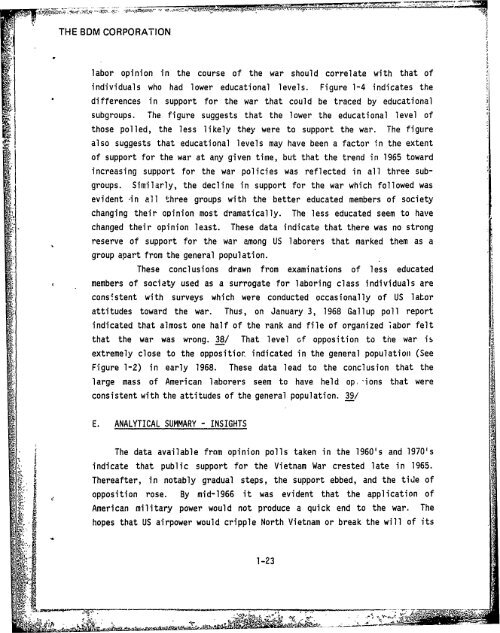policy - The Black Vault
policy - The Black Vault
policy - The Black Vault
You also want an ePaper? Increase the reach of your titles
YUMPU automatically turns print PDFs into web optimized ePapers that Google loves.
THE BDM CORPORATION<br />
labor opinion in the course of the war<br />
should correlate with that of<br />
individuals who had lower educational levels. Figure 1-4 indicates the<br />
differences in support for the war that could be traced by educational<br />
subgroups.<br />
<strong>The</strong> figure suggests that the lower the educational level of<br />
those polled, the less likely they were to support the war.<br />
<strong>The</strong> figure<br />
also suggests that educational levels may have been a factor in the extent<br />
of support for the war at any given time, but that the trend in 1965 toward<br />
increasing support for the war policies was reflected in all three subgroups.<br />
Similarly, the decline in support for the war which followed was<br />
evident *in all three groups with the better educated members of society<br />
changing their opinion most dramatically. <strong>The</strong> less educated seem to have<br />
changed their opinion least. <strong>The</strong>se data indicate that there was no strong<br />
reserve of support for the war among US<br />
group apart from the general population.<br />
laborers that marked them as a<br />
<strong>The</strong>se conclusions drawn from examinations of less educated<br />
members of society used as a surrogate for laboring class individuals are<br />
consistent with surveys which were conducted occasionally of US labor<br />
attitudes toward the war. Thus, on January 3, 1968 Gallup poll report<br />
indicated that almost one half of the rank and file of organized labor felt<br />
that the war was wrong. 38/ That level of opposition to the war is<br />
extremely close to the oppositior, indicated in the general population (See<br />
Figure 1-2) in early 1968. <strong>The</strong>se data lead to the conclusion that the<br />
large mass of American laborers seem to have held op, ions that were<br />
consistent with the attitudes of the general population. 39/<br />
E. ANALYTICAL SUMMARY - INSIGHTS<br />
<strong>The</strong> data available from opinion polls taken in the 1960's and 1970's<br />
indicate that public support for the Vietnam War crested late in 1965.<br />
<strong>The</strong>reafter, in notably gradual steps, the support ebbed, and the tide of<br />
opposition rose. By mid-1966 it was evident that the application of<br />
American military power would not produce a quick end to the war.<br />
hopes that US airpower would cripple North Vietnam or break the will of its<br />
<strong>The</strong><br />
1-23
















